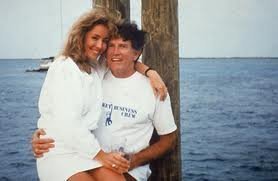
A baseball is a ball used in the sport of the same name. The ball consists of a rubber or cork center wrapped in yarn and covered with white natural horsehide or cowhide, or a synthetic composite leather. A regulation baseball is 9 to 9¼ inches in circumference ie 2.86 to 2.94 inches in diameter, with a weight of 5 to 5¼ oz. A baseball is bound together by 108 hand-woven stitches through the cowhide leather.
The leather cover is commonly formed from two saddle-shaped pieces stitched together, typically with red-dyed thread. That stitching plays a significant role in the trajectory of a thrown baseball due to the drag caused by the interaction between the stitching and the air. Controlling the orientation of the stitches and the speed of the ball's rotation allows a pitcher to affect the behavior of the pitched ball in specific ways. Commonly employed pitches include the curveball, the slider, the two-seam fastball, the four-seam fastball, the sinker, the cutter and the changeup.
In the early, mid-1800s days of baseball, there was a great variety in the size, shape, weight, and manufacturing of baseballs. Early baseballs were made from a rubber core from old, melted shoes, wrapped in yarn and leather. Fish eyes were also used as cores in some places. Pitchers usually made their own balls, which were used throughout the game, softening and coming unraveled as the game went on. One of the more popular earlier ball designs was the "lemon peel ball," named after its distinct four lines of stitching design. Lemon peel balls were darker, smaller, and weighed less than other baseballs, prompting them to travel further and bounce higher, causing very high-scoring games.
In the mid-1850s, teams in and around New York met in an attempt to standardize the baseball. They decided to regulate the weight of baseballs at 51⁄2–6 oz, and with a circumference of 8–11 inches. There were still many variations of baseballs since they were completely handmade. Balls with more rubber and a tighter winding went further and faster (known as "live balls"), and balls with less rubber and a looser winding (known as "dead balls") did not travel as far or fast. This is generally true for all baseballs. Teams often used this knowledge to their advantage, as players from the team usually manufactured their own baseballs to use in games.
There is no agreement on who invented the commonplace figure-8 stitching on baseballs. Some historians say it was invented by Ellis Drake, a shoemaker's son, to make the cover stronger and more durable. Others say it was invented by Colonel William A. Cutler and sold to William Harwood in 1858. Harwood built the nation's first baseball factory in Natick, Massachusetts, and was the first to popularize and mass-produce baseballs with the figure-8 design.
In 1876, the National League (NL) was created, and standard rules and regulations were put in place. A.G. Spalding, a well-known baseball pitcher who made his own balls, convinced the NL to adopt his ball as the official baseball for the NL. It remained that way for a century.
In 1910, the cork-core ball was introduced. They outlasted rubber core baseballs; and for the first few years they were used, balls were hit farther and faster than rubber core balls. It eventually went back to normal. Pitchers adapted with the use of the spitball, which is now illegal, and an emphasis on changing the ball.
In 1920, a couple of important changes were made to baseballs. They began to be made using machine winders and a higher grade of yarn from Australia. Although there was no evidence that these balls impacted the game, offensive statistics rose throughout the 1920s, and players and fans alike believed the new balls helped batters hit the ball farther.
In 1925, Milton Reach patented his "cushion cork" center. It was a cork core surrounded by black rubber, then another layer of red rubber.
In 1934, The National League and American League came to a compromise and standardized the baseball. They agreed on a cushion cork center; two wrappings of yarn; a special rubber cement coating; two more wrappings of yarn; and, finally, a horsehide cover.
Baseballs have gone through only a few small changes since the compromise. During World War II, the United States banned the use of rubber for non war-related goods, including for baseballs. So in 1943, instead of using rubber, baseballs were made with rubber-like shells of balata (also used in golf balls), which is obtained from a particular type of tropical tree. Hitting declined significantly that year.
The introduction of synthetic rubber in 1944 resulted in baseballs' returning to normal. Offense would return to normal after the change back to the regular ball and return of players from active duty.
In 1974, due to a shortage of the material, horsehide was replaced by the more abundant cowhide as the cover material.
In 1976, MLB ended its relationship with Spalding for manufacturing their baseballs and switched to Rawlings, which still provides the balls to MLB today.
A significant increase in the number of home runs since the start of the 2016 baseball season caused MLB officials to establish a committee that would examine the manufacturing process. In December 2019, MLB officials said that a lower stitching seam profile had most likely led to the increase in home runs, but also pledged to consider studying the issue. On February 5, 2021 MLB issued a memo that said that Rawlings had altered their manufacturing process to reduce the bounce in the balls and that after extensive testing, "... we are comfortable that these baseballs meet all of our performance specifications." The same memo also noted that more teams had applied for permission to use humidors to store their baseballs. As of 2020 only the Arizona Diamondbacks, Boston Red Sox, Colorado Rockies, and Seattle Mariners, were using the devices.
If you want to read a lot more, go here: https://en.wikipedia.org/wiki/Baseball_(ball)
- 8 eggs
- 1 cup milk
- 1/2 teaspoon salt
- 1/4 teaspoon black pepper
- 1 (16-ounce) package frozen shredded hash brown potatoes, thawed
- 1 (9.6-ounce) package frozen sausage links, cut into 1/4-inch pieces
- 2 cups frozen peppers & onions, thawed and dried on a paper towel
- 2 1/2 cups shredded sharp cheddar cheese
- Preheat oven to 375º. Coat a 9- x 13-inch baking dish with cooking spray.
- In a large bowl, whisk eggs, milk, salt, and black pepper. Add potatoes, sausage, peppers & onions, and cheese; mix until thoroughly combined. Pour into baking dish.
- Bake 40 to 45 minutes or until center is set. Cut into squares and serve.
****Besides being so easy to throw together, you can try other veggies, cheeses, and meats to make a different bake every week that your family will love.
Each year on November 28th, people across the United States enjoy National French Toast Day. Also known as eggy bread or omelet bread, it makes a great breakfast for guests or part of a brunch.
Home cooks and professionals alike whip up a few personal favorites when it comes to french toast recipes. The base consists of eggs and milk whisked together. Bread is dipped into the mixture and fried until golden. Many people also add some sugar, vanilla, and cinnamon to the base.
The flavor of French toast can be brightened with a squeeze of fresh orange or stuffed with sauteed apples and cinnamon. Make French toast kid-friendly by cutting it into sticks. Then dip the sticks into syrup. Substitute sugary syrup with a fruit puree and fresh fruit pieces. Nuts and seeds add crunch to this delicious breakfast fare, and don’t forget the whipped cream! Just a dollop goes a long way.
Make French toast as part of a big breakfast. Freeze leftovers for easy breakfasts later in the week. Have breakfast for dinner. Share your favorite French toast recipes. Do you love cinnamon and vanilla? What’s the best fruit toppings? Add apple butter or another jam.
The term “French toast” is primarily used in the United States. However, similar dishes served in the rest of the world go by a variety of names including:
Poor knights (arme riddere) – Denmark, Norway, and Germany
Bombay toast – India
Eggy bread or Gypsy toast – United Kingdom
Lost bread (pain perdu) – France and New Orleans


.jpg)








